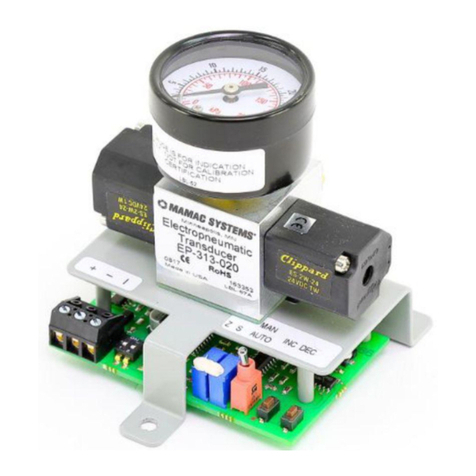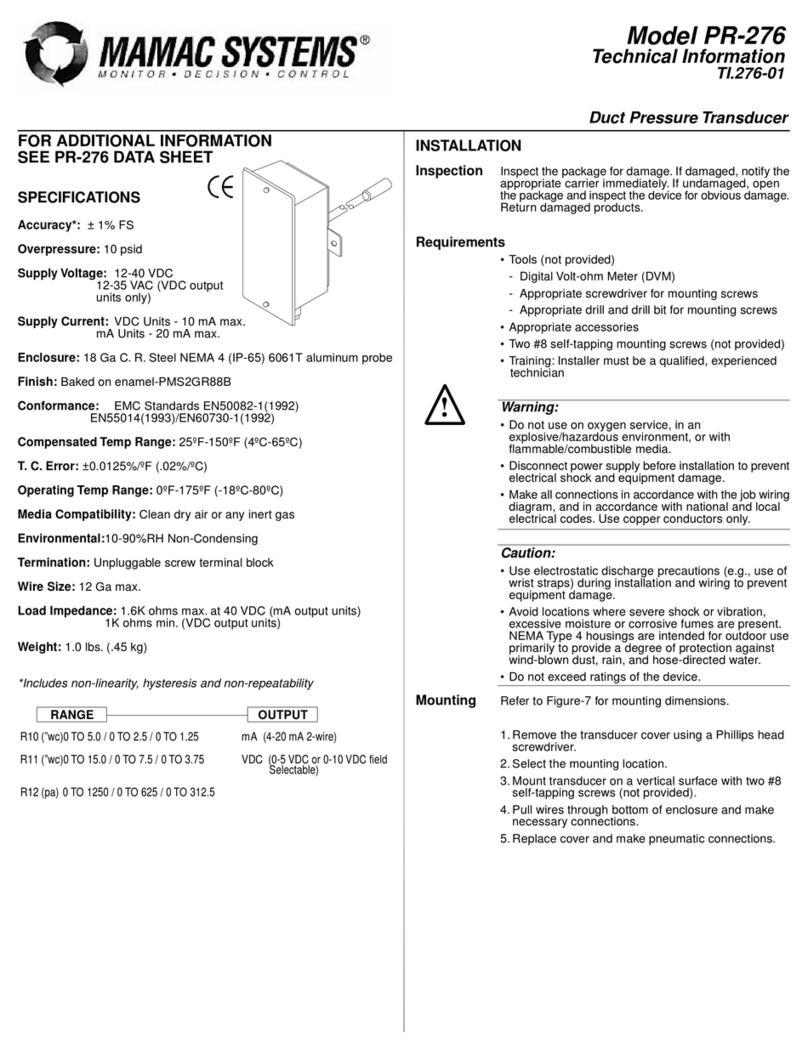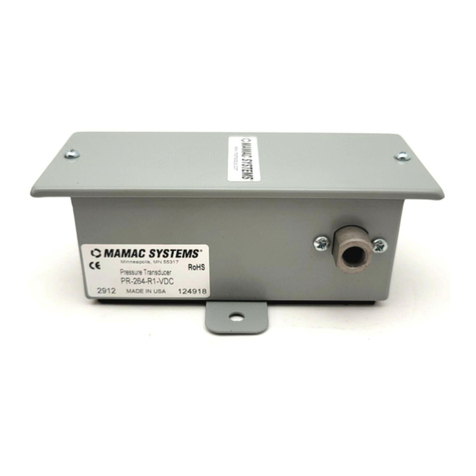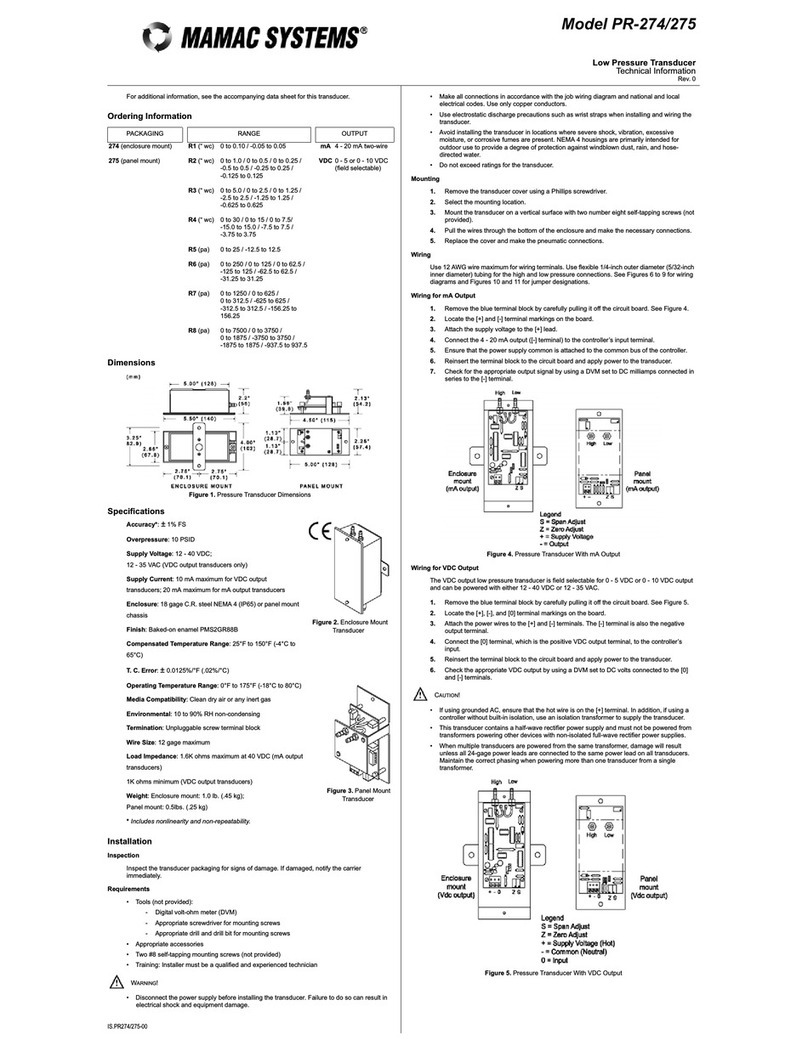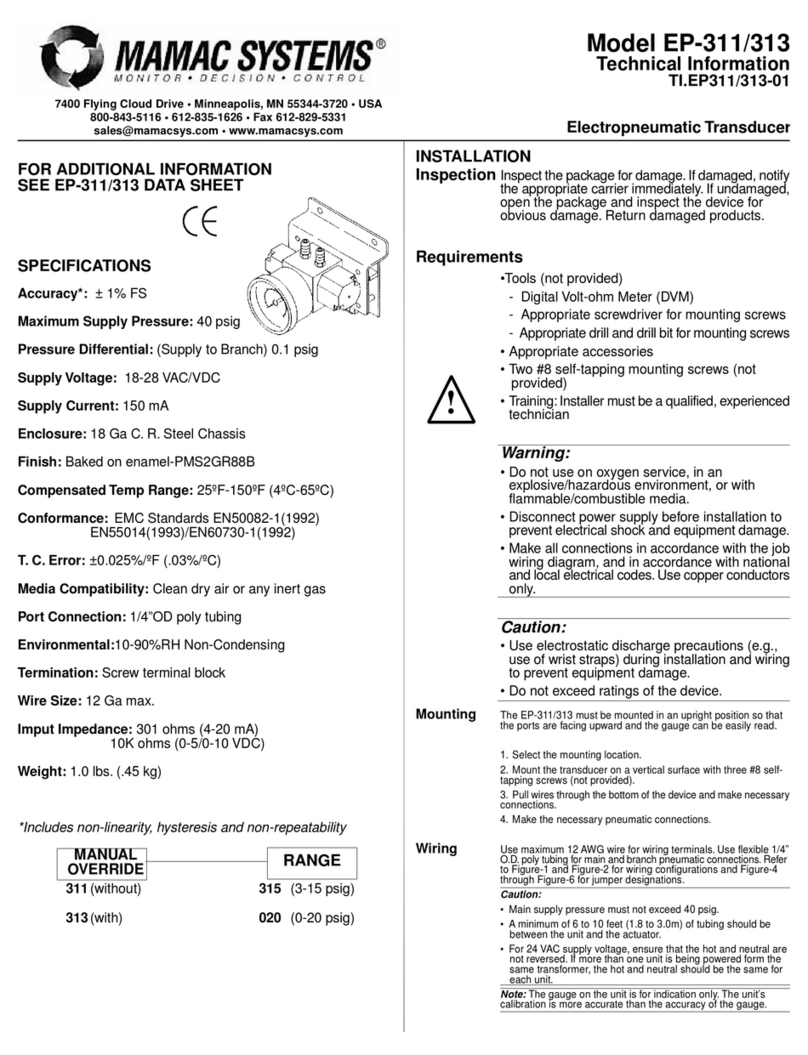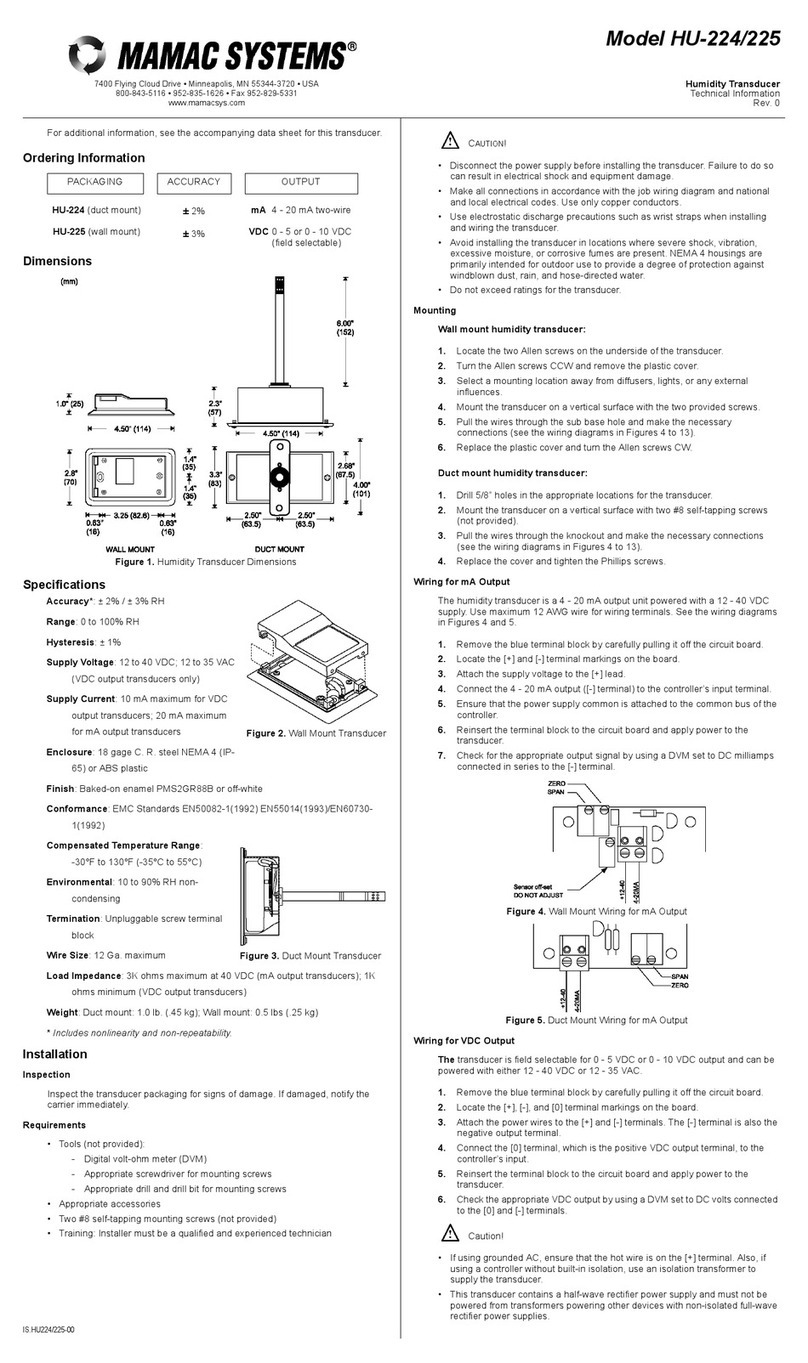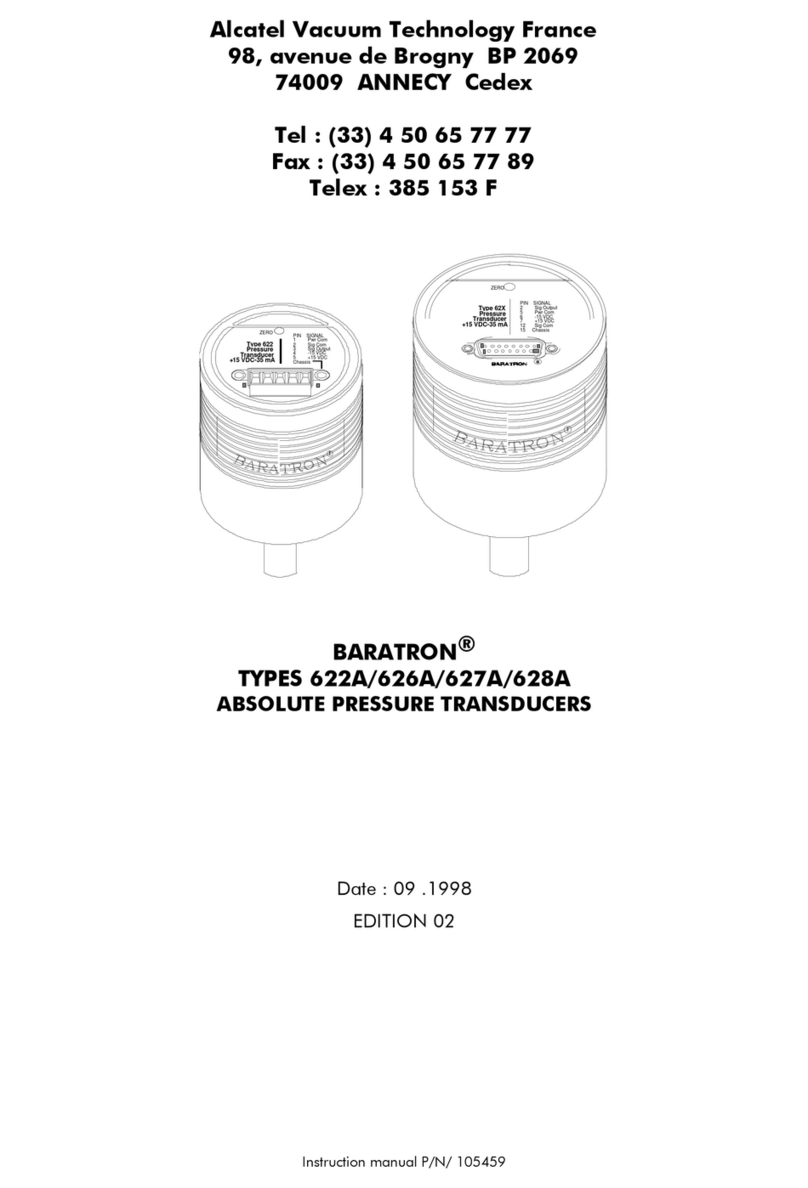
Model PR-283
Differential Pressure Transducer With Manifold
Technical Information
Rev. 0
7400 Flying Cloud Drive • Minneapolis, MN 55344-3720 • USA
800-843-5116 • 952-835-1626 • Fax 952-829-5331
www.mamacsys.com
IS.PR283-00
For additional information, see the accompanying data sheet for this transducer.
Ordering Information
Dimensions
Figure 1. Differential Pressure Transducer and Manifold Dimensions
Figure 2. Manifold (VM-705) Dimensions
Specifications
Accuracy*:±1% FS
Overpressure: 300% of rated range
Burst Pressure: 500% of rated range
Maximum Static Pressure: 200% of DP range
Supply Voltage: 12 - 40 VDC;
12 - 35 VAC (VDC output transducers only)
Supply Current: 10 mA maximum VDC output transducers;
20 mA maximum mA output transducers
Enclosure: 18 gage C.R. steel NEMA 4 (IP 65)
Finish: Baked-on enamel PMS2GR88B
Conformance: EMC Standards EN50082-1(1992), EN55014(1993)/EN60730-1(1992), AS/NZ
3548 (1995) EN55022:IEC/CISPR 22 (1993)
Compensated Temperature Range: 0°F to 180°F (-18°C to 82°C)
T. C. Erro r:±0.025%/°F (.03%/°C)
Media Compatibility: Liquids and gases compatible to 316L stainless steel
Port Connection: 1/8-inch NPT
Environmental: 10 to 90% RH non-condensing
Termination: Unpluggable screw terminal block
Wire Size: 12 gage maximum
Load Impedance: 3,000 ohms maximum at 40 VDC (mA output transducers);
1,000 ohms minimum (VDC output transducers)
Weight: 1.0 lb. (.45 kg)
*Includes nonlinearity, hysteresis, and non-repeatability.
Installation
Inspection
Inspect the transducer packaging for signs of damage. If damaged, notify the carrier
immediately.
Requirements
• Tools (not provided):
- Digital volt-ohm meter (DVM)
- Appropriate screwdriver for mounting screws
- Appropriate drill and drill bit for mounting screws
• Appropriate accessories
• Six #10 mounting screws (not provided)
• Training: Installer must be a qualified and experienced technician
WARNING!
• Do not use on oxygen service, in an explosive or hazardous environment, or with flammable
or combustible material.
• Disconnect the power supply before installing the transducer. Failure to do so can result in
electrical shock and equipment damage.
• Make all connections in accordance with the job wiring diagram and national and local
electrical codes.
• Use electrostatic discharge precautions such as wrist straps when installing and wiring the
transducer.
• Avoid installing the transducer in locations where severe shock, vibration, excessive
moisture, or corrosive fumes are present. NEMA 4 housings are primarily intended for
outdoor use to provide a degree of protection against windblown dust, rain, and hose-
directed water.
• Do not exceed ratings for the transducer.
Mounting
Mount the differential pressure transducer on a vertical surface with the 1/8-inch NPT
connection pointing downwards. See Figures 1 and 2 for the transducer’s mounting
dimensions.
1. Mount the valve manifold on the wall using four #10 screws (not provided).
2. Run piping into the valve manifold.
3. Slide the transducer’s male fittings into the compression fittings on the valve manifold.
4. Fasten the transducer to the wall using two #10 screws (not provided).
5. Tighten the valve manifold compression nut until finger tight. Scribe the compression nut
at the 6 o'clock position and then tighten the nut one and one-quarter turns to the 9 o'clock
position.
6. The connection can be disconnected and retightened many times. When retightening the
nut, tighten only until light resistance is felt (original tight position).
7. Run conduit and wiring to the transducer. Connect wiring as shown in Figures 4 through 7,
and set the switch to the correct position.
8. Open the nulling valve (center valve), low pressure valve, high pressure valve, and then
close the nulling valve.
Wiring
Use 12 AWG wire maximum for wiring terminals and copper or stainless steel tubing for the
transducer connections. See Figures 4 through 7 for wiring diagrams and Figures 8 and 9 for
jumper designations.
Wiring for mA Output
The mA output differential pressure transducer must be powered with a 12 - 40 VDC power
supply.
1. Remove the blue terminal block by carefully pulling it off the circuit board. See Figure 4.
2. Locate the [+] and [-] terminal markings on the board.
3. Attach the supply voltage to the [+] lead.
4. Connect the 4 - 20 mA output ([-] terminal) to the controller’s input terminal.
5. Ensure that the power supply common is attached to the common bus of the controller.
6. Reinsert the terminal block to the circuit board and apply power to the transducer.
7. Check for the appropriate output signal by using a DVM set to DC milliamps connected in
series to the [-] terminal.
Figure 4. Differential Pressure Transducer With mA Output
Wiring for VDC Output
The VDC output differential pressure transducer is field selectable for 0 - 5 VDC or 0 - 10 VDC
output and can be powered with either 12 - 40 VDC or 12 - 35 VAC.
1. Remove the blue terminal block by carefully pulling it off the circuit board. See Figure 5.
2. Locate the [+], [-], and [0] terminal markings on the board.
3. Attach the power wires to the [+] and [-] terminals. The [-] terminal is also the negative
output terminal.
4. Connect the [0] terminal, which is the positive VDC output terminal, to the controller’s
input.
5. Reinsert the terminal block to the circuit board and apply power to the transducer.
6. Check the appropriate VDC output by using a DVM set to DC volts connected to the [0]
and [-] terminals.
CAUTION!
• If using grounded AC, ensure that the hot wire is on the [+] terminal. In addition, if using a
controller without built-in isolation, use an isolation transformer to supply the transducer.
• This transducer contains a half-wave rectifier power supply and must not be powered from
transformers powering other devices with non-isolated full-wave rectifier power supplies.
• When multiple transducers are powered from the same transformer, damage will result
unless all 24-gage power leads are connected to the same power lead on all transducers.
Maintain the correct phasing when powering more than one transducer from a single
transformer.
RANGE OUTPUT
R1 (psig)
R2 (psig)
R3 (psig)
R4 (kPa)
R5 (kPa)
R6 (kPa)
0 to 5.0 / 0 to 10 / 0 to 20
0 to 25 / 0 to 50 / 0 to 100
0 to 75 / 0 to 150 / 0 to 300
0 to 35 / 0 to 70 / 0 to 140
0 to 175 / 0 to 350 / 0 to 700
0 to 500 / 0 to 1000 / 0 to 2000
mA
VDC
4 - 20 mA two-wire
0 - 5 or 0 - 10 VDC
(field selectable)
Figure 3. Differential Pressure
Transducer

